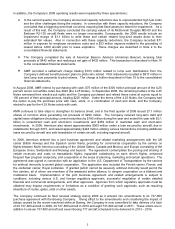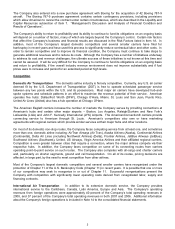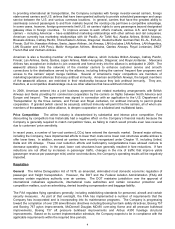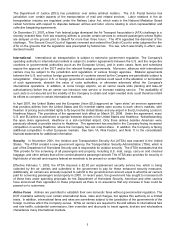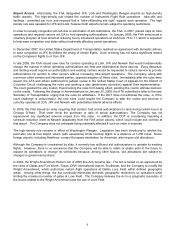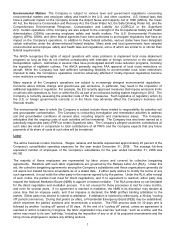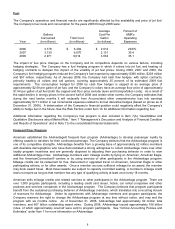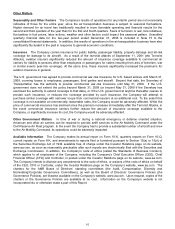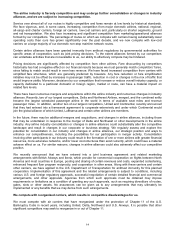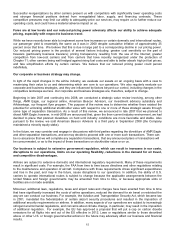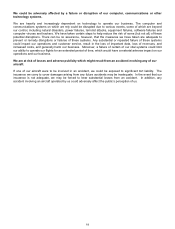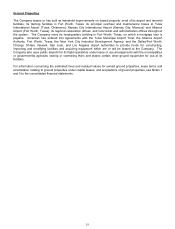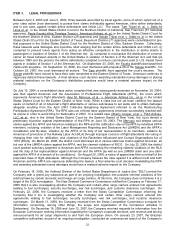American Airlines 2008 Annual Report Download - page 15
Download and view the complete annual report
Please find page 15 of the 2008 American Airlines annual report below. You can navigate through the pages in the report by either clicking on the pages listed below, or by using the keyword search tool below to find specific information within the annual report.12
A number of other factors, including our financial results in recent years, our substantial indebtedness, the difficult
revenue environment we face, our reduced credit ratings, recent historically high fuel prices, and the financial
difficulties experienced in the airline industry, adversely affect the availability and terms of funding for us. In
addition, the global economic downturn and recent severe disruptions in the capital markets and other sources of
funding have resulted in greater volatility, less liquidity, widening of credit spreads, and substantially more limited
availability of funding. As a result of these factors, there can be no assurance that additional funding will be
available to us on acceptable terms, if at all. An inability to obtain necessary additional funding on acceptable
terms would have a material adverse impact on us and on our ability to sustain our operations.
Our initiatives to generate additional revenues and to reduce our costs may not be adequate or
successful.
As we seek to improve our financial condition, we must continue to take steps to generate additional revenues and
to reduce our costs. Although we have a number of initiatives underway to address our cost and revenue
challenges, some of these initiatives involve changes to our business which we may be unable to implement. In
addition, we expect that, as time goes on, it will be progressively more difficult to identify and implement significant
revenue enhancement and cost savings initiatives. The adequacy and ultimate success of our initiatives to
generate additional revenues and reduce our costs are not known at this time and cannot be assured. Moreover,
whether our initiatives will be adequate or successful depends in large measure on factors beyond our control,
notably the overall industry environment, including passenger demand, yield and industry capacity growth, and fuel
prices. It will be very difficult for us to continue to fund our obligations on an ongoing basis, and to return to
profitability, if the overall industry revenue environment does not improve substantially and if fuel prices were to
increase and persist for an extended period at high levels.
We may be adversely affected by increases in fuel prices, and we would be adversely affected by
disruptions in the supply of fuel.
Our results are very significantly affected by the volatile price and the availability of jet fuel, which are in turn
affected by a number of factors beyond our control. Fuel prices have only recently declined from historic high
levels.
Due to the competitive nature of the airline industry, we may not be able to pass on increased fuel prices to
customers by increasing fares. Although we had some success in raising fares and imposing fuel surcharges in
reaction to recent high fuel prices, these fare increases and surcharges did not keep pace with the extraordinary
increases in the price of fuel that occurred in 2007 and 2008. Furthermore, even though fuel prices have declined
significantly from their recent historic high levels, reduced demand or increased fare competition, or both, and
resulting lower revenues may offset any potential benefit of these lower fuel prices.
While we do not currently anticipate a significant reduction in fuel availability, dependence on foreign imports of
crude oil, limited refining capacity and the possibility of changes in government policy on jet fuel production,
transportation and marketing make it impossible to predict the future availability of jet fuel. If there are additional
outbreaks of hostilities or other conflicts in oil producing areas or elsewhere, or a reduction in refining capacity
(due to weather events, for example), or governmental limits on the production or sale of jet fuel, there could be a
reduction in the supply of jet fuel and significant increases in the cost of jet fuel. Major reductions in the availability
of jet fuel or significant increases in its cost would have a material adverse impact on us.
We have a large number of older aircraft in our fleet, and these aircraft are not as fuel efficient as more recent
models of aircraft. We believe it is imperative that we continue to execute our fleet renewal plans. However, due
to the recent machinist strike at Boeing, deliveries of the Boeing 737-800 aircraft we currently have on order have
been delayed. In addition, we expect delays in the deliveries of the Boeing 787-9 aircraft we currently have on
order.
While we seek to manage the risk of fuel price increases by using derivative contracts, there can be no assurance
that, at any given time, we will have derivatives in place to provide any particular level of protection against
increased fuel costs. In addition, a deterioration of our financial position could negatively affect our ability to enter
into derivative contracts in the future. Moreover, declines in fuel prices below the levels established in derivative
contracts may require us to post cash collateral to secure the loss positions on such contracts, and if such
contracts close when fuel prices are below the applicable levels, we would be required to make payments to close
such contracts; these payments would be treated as additional fuel expense.


